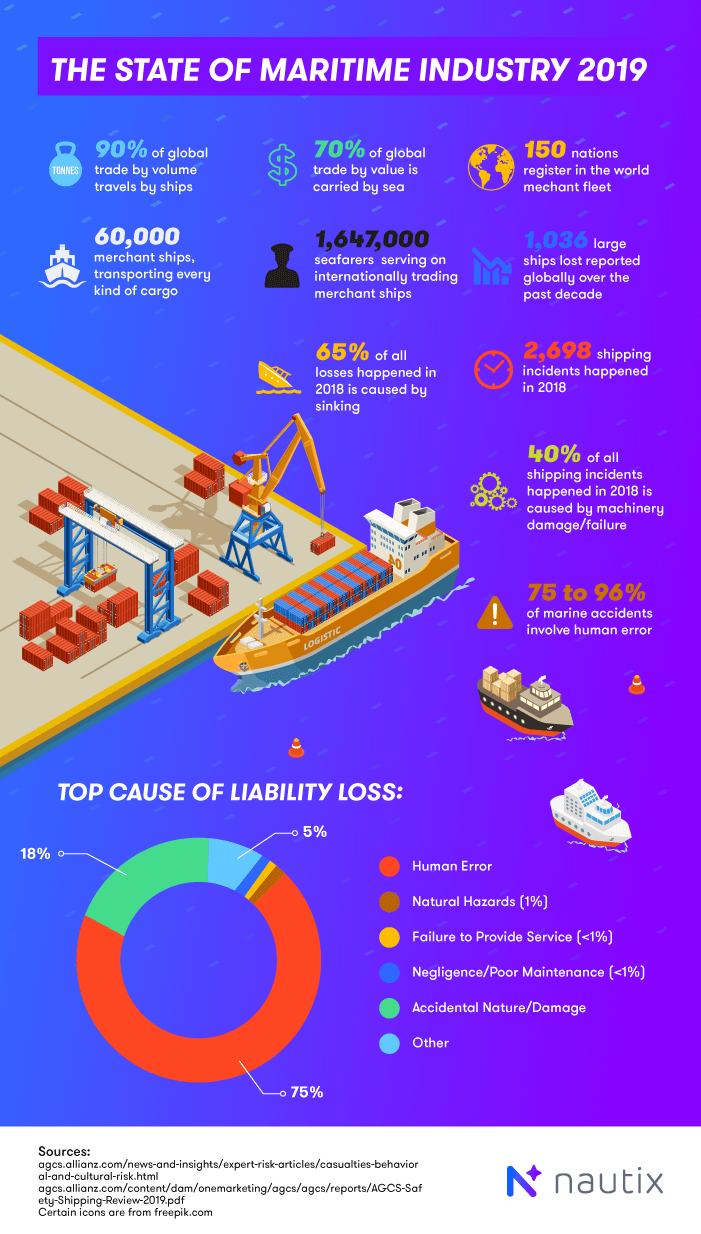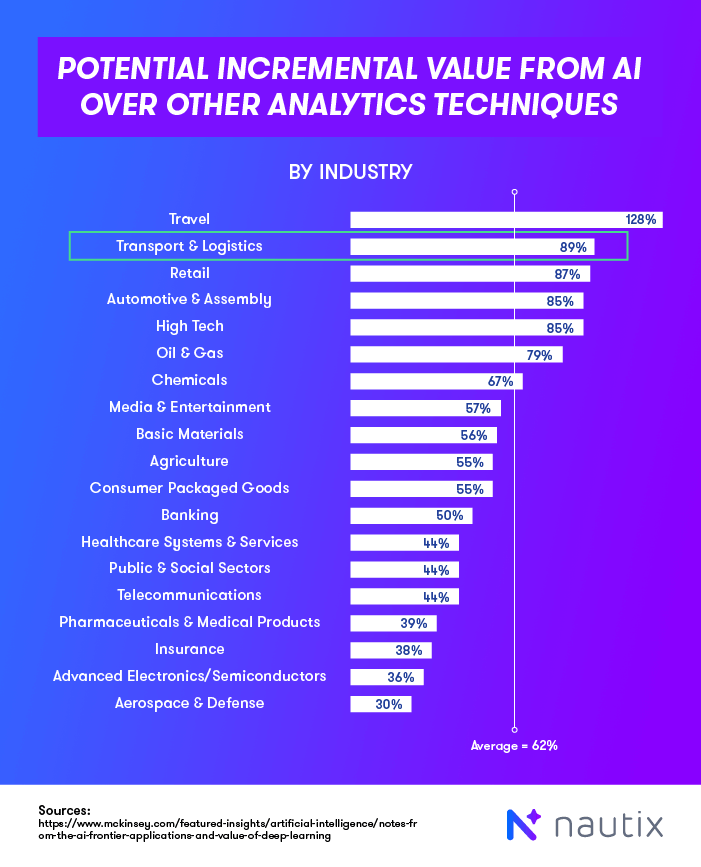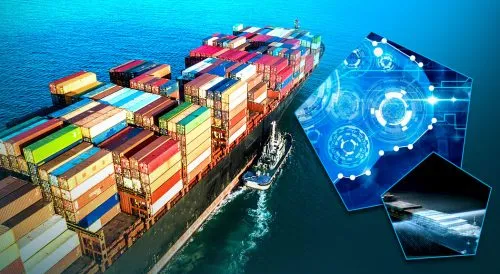The State of Maritime Industry
Over the past 50 years, global maritime freight transportation has undergone remarkable developments. The international shipping industry is responsible for carrying the vast majority of international trade with its share ranging from 80 to 90 per cent of world trade. In terms of trade value, the shipping share accumulates between 60 and 70 per cent of trade.
In this new in-depth guide done by Nautix Technologies, the following topics are covered:
The State of Maritime Industry 2019: Global Statistics
4 Ways AI Can Boost Safety and Efficiency at Sea
Supported by the 2017 upswing in the world economy, global seaborne trade grew at the rate of 4 per cent, the fastest expansion recorded in a 5-year period. Total shipping volume reached 10.7 billion tons, ended 2017 with a total revenue of roughly USD166 billion. Container freight rate levers increased, which resulted in USD7 billion profit, with average earnings increased in all fleet segments, approximately USD11 thousand per day.
“Global maritime freight transportation revenue is estimated to reach USD205 billion by 2023 There are around 60,000 merchant ships, transporting every kind of cargo — including containerized and bulk commodities. Ship traffic has grown substantially denser, with the world fleet registered in over 150 nations, manned by over a million seafarers, which has raised the stakes of maritime safety and called for technology advances in the maritime industry.”
HUMAN ERROR IN MARITIME ACCIDENTS
Despite decades of safety improvements, there were 1,036 large ships lost reported around the world over the past decade, according to AGCS’s Safety & Shipping Review 2019.
As reported In 2018, there was a total of 2,698 shipping incidents (casualties). And human behaviour is often a factor, in spite of years of developments in maritime safety regulation, training, technology, and risk management.
Reasons can range from crew members on phones or an over-reliance on other forms of technology, fatigue, time-, resource-, and commercial-pressure, or a failure of organizational culture and behaviour.
Fatal accidents such as the sinking of the El Faro in late 2015 and the grounding of the Costa Concordia in 2012. More recently, the “Sanchi” oil tanker collision in January 2018 and the loss of the “El Faro” in Hurricane Joaquin in late 2016, have all been linked to human behaviour errors.
It is estimated that 75 to 96 per cent of marine accidents involve human error. Additionally, human involvement reportedly accounted for roughly 75 per cent of the value of almost 15 thousand marine liability insurance claims from 2011 to 2016 — costing over USD1.6 billion.
As explained by Captain Rahul Khanna, Global Head of Marine Risk Consulting at AGCS, “Safety rules and regulations are in place and are mostly followed, but there are some aspects of human nature that we are not addressing as an industry. Understanding human behaviour and how it can lead to accidents is the missing link in the shipping industry today.”

(Image Courtesy: Nautix Technologies)
Artificial Intelligence Revolutionising the Maritime Industry
The speed of innovation is increasing, especially with the rise of new digital industrial technologies known as Industry 4.0, underpinned by transformational technologies of Artificial Intelligence (AI) and machine learning.
With the mountain of data generated by the Internet of Things (IoT), AI and its human intelligence simulation power step in, recognise patterns, connect disparate data points, analyse, predict and proactively exhibit autonomous behaviour, where little or no human intervention is required.
Thanks to the rapid pace of developments in AI, there are numerous of unprecedented opportunities to enhance the performance of different industries and businesses. Even though the transport and logistics industry has been slower to introduce digital innovations than many other industries, according to McKinsey & Company’s prediction, it will be one of the industries that will experience the most value generation from this technology advancement, especially in minimising accidents at sea.

(Image Courtesy: Nautix Technologies)
Sharing the same opinion, Captain Rahul Khanna emphasises that: “By analysing data 24/7 we can gain new insights from crew behaviour and near-misses that can identify trends. The shipping industry has learned from losses in the past but predictive analysis could be the difference between a safe voyage and a disaster.”
“It is no longer sufficient to analyse data just once or twice a year. It should be done in ‘real time’. This is possible with technology already available.”
4 Ways AI can Help to Minimise Shipping Accidents
The industry is already investing in several types of AI usage, especially in the Nordics. Statistics show that AI could potentially unlock USD10 – 13.3 billion of value for transport and logistics businesses in the region, as a result, it can boost business profits in the region as much as 4.3 per cent.
OPERATIONAL RISK MANAGEMENT
In a complex and high-pressure operating environment — like at sea, where precision is key, even the best preparation and efforts can go awry, and resulting in a loss or an insurance claim. It is not surprising therefore that operational risk management is receiving more attention within the shipping industry.
Thanks to major progress in the development of artificial intelligence, solutions like Nautix Technologies are developed to not only help with planning and managing tasks but also analysing accidents or incidents in the past. It helps to recognise trends and possible factors, all in an effort to predict operational risks for the upcoming operation, allowing crew members to make better decisions and operate safely and efficiently.
VOYAGE OPTIMISATION
By harnessing data — such as weather patterns, port conditions including loading time, and route updates — from an increasingly connected global supply chain and other external sources, AI-powered platforms like MyRouteAppraisal (MyRA) and Optimum Voyage, can help to guide ship captains to make more profitable and safer choices.
Using the data provided, captains can, for instance, calculate risks and predict delays due to bad weather or traffic congestion. As a result, re-plan his route or re-estimate arrival time for better port loading organising, as well as avoiding accidents in congested water.
MAINTENANCE PREDICTION
By a rise in machinery damage incidents, machinery damage has become the top cause of casualties around the globe in 2018. According to statistics, there have been 8,862 machinery damage incidents in 10 years. Hence, predicting and preventing mechanical failures before they occur is a priceless capability that AI has to offer.
By gaining insights from analysing vessels operation data, AI can then detect any technical anomalies, allowing ship operators to optimise component replacement intervals, and perform maintenance effectively and economically, reducing the frequency of costly stops.
NAVIGATION SOLUTION
Even when AI can notify ship captains if there are any congestions in route, there are still risks of marine collisions due to other causes, such as severe weather or low-light conditions. Statistically speaking, collision and sinking has caused 53 per cent of all vessel losses over the past10 years and was the primary cause of 65 per cent of all losses happened in 2018.
Coming to aid, a new AI-powered navigational safety, sensor technology, called Orca AI, is being tested. It will help to provide additional information about surrounding vessels and hazards, specially designed for use in crowded waterways and in the lowest visibility, as an attempt of reducing collisions at both long and short distances.
Gearing Up for the Next Phase of Maritime
The global seaborne transport demand will continue to grow. And, there is no doubt that technology, when used in the right manner, can strengthen this age-old industry.
The shipping industry has woken up to technology and is embracing many new technologies — including cloud computing, the Internet of Things (IoT), Blockchain, sophisticated sensors, data capture and analytics, advanced robotics and artificial intelligence (AI).
AI is still at its infancy, but as suggested by the McKinsey Global Institute, AI will transform the society ten times faster and at 300 times the scale, or about 3,000 times the impact’ of the industrial revolution.
It offers a huge opportunity to all sectors of society, not least the maritime sector, which will benefit from being able to conduct its business faster, cheaper, more efficiently, and most importantly safer.






